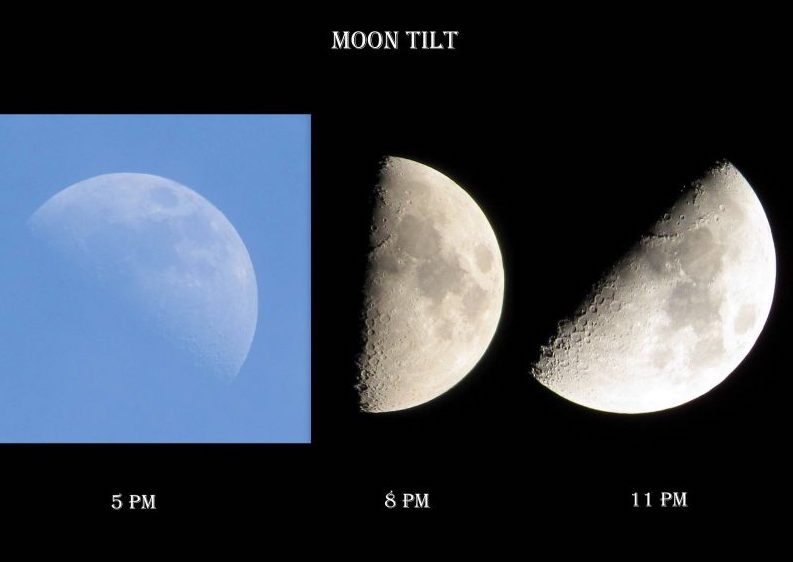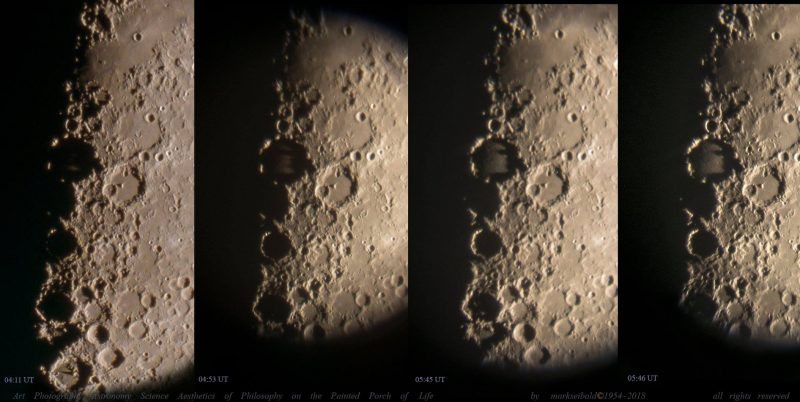

Bridget Borchert in Bloomington, Minnesota, wrote: “The tilt of the moon through the evening fascinates me.”
We all see the same moon phase, more or less, on the same day. Yet many people report perplexities related to the moon’s phase. Rowena in Australia wrote, for example:
I was mainly wondering about the locations of the seas and craters appearing differently. For example, when I take a photo of the moon, the Sea of Serenity appears in one place, but from other countries it seems to be located somewhere else.
Stumped down under,
Rowena
So … here’s a big part of the answer. The Northern and Southern Hemispheres see the moon oriented differently with respect to the horizon. The change in orientation leads to differences that can be hard to comprehend! For one thing, observers in the Northern and Southern Hemispheres see the moon apparently upside-down with respect to each other. You can see that if you scrutinize the moon’s features in the images below. Notice that – for example – from the Northern Hemisphere, a waxing moon (from new moon to full moon) increases its phase from right to left.

Northern Hemisphere. Image via primaryhomeworkhelp.co.uk.
From the Southern Hemisphere, meanwhile, a waxing moon (from new moon to full moon) increases its phase from left to right. Why so different? Think of the moon’s path across your sky. Just picture yourself standing there, looking at it. From the Northern Hemisphere, we look generally southward to see the moon (or sun) crossing our sky. From the Southern Hemisphere, people look generally northward to see the moon (or sun) crossing the sky. Can you see why that shift in your orientation on the globe would cause you to see the moon differently?

Southern Hemisphere. Image via primaryhomeworkhelp.co.uk.
But there are other differences. Look back at Bridget Borchert’s image at the top of this post. No matter where you are on Earth, the moon itself shifts its orientation with respect to your horizon as it moves across your sky. I hope the photo at top – showing the moon’s changing face throughout a single evening – is self-explanatory. If you do have questions, though, please ask them in the comments below, and I’ll try to answer, if I can.
Just remember, your time zone also makes a small difference in how you view the moon’s phase. That’s because – as Earth turns under the sky, and the moon rises for successive time zones – the moon is continually waxing or waning.
A final thought. What we on Earth call moon phases are really about sunrise and sunset on the moon. Astronomers call the line between light and dark on the moon the terminator line. That’s the line of sunrise or sunset on the moon, and it shifts, just as the line of sunrise and sunset on Earth is constantly shifting. Earth spins relatively fast, approximately once every 24 hours. The moon spins on its axis only once each earthly month, and its line of sunrise/set moves slowly. It’s wonderful fun to beg or borrow a telescope for a night when the moon is up … and watch for yourself over several hours as the shadows slowly shift on the moon, as the lunar sunrise or sunset slowly creeps across the moon’s face. A great way to clear the mind!

View larger. | Mark Seibold caught the progression of shadows and light on crater rims and floors – across about 1 1/2 hours – at lunar sunrise (along the terminator line, or line between light and dark on the moon) on a 7-day-old moon on April 22, 2018. The large crater here is 95-mile-wide (150-km-wide) Ptolemaeus. Celestron Nexstar 5i, with Sony NEX5R directly through telescope, and 12.4mm Meade eyepiece projection.

Flickr user Mike O’Hara kindly labeled the wealth of named features along the moon’s terminator line – line of sunrise – on a waxing moon. If you had a telescope, as the line of sunrise slowly shifts, you could watch over several hours to see the shadows playing along the rims of these and many other lunar mountains and craters.
Bottom line: The whole Earth sees the same moon phase on the same day, but the Northern and Southern Hemispheres see the moon oriented differently with respect to the horizon. The moon itself shifts its orientation with respect to your horizon as it moves across your sky. Finally, your time zone makes a small difference in how you view the moon’s phase.
Want more? Visit this page at primaryhomeworkhelp.co.uk
from EarthSky http://bit.ly/2WhPhDx


Bridget Borchert in Bloomington, Minnesota, wrote: “The tilt of the moon through the evening fascinates me.”
We all see the same moon phase, more or less, on the same day. Yet many people report perplexities related to the moon’s phase. Rowena in Australia wrote, for example:
I was mainly wondering about the locations of the seas and craters appearing differently. For example, when I take a photo of the moon, the Sea of Serenity appears in one place, but from other countries it seems to be located somewhere else.
Stumped down under,
Rowena
So … here’s a big part of the answer. The Northern and Southern Hemispheres see the moon oriented differently with respect to the horizon. The change in orientation leads to differences that can be hard to comprehend! For one thing, observers in the Northern and Southern Hemispheres see the moon apparently upside-down with respect to each other. You can see that if you scrutinize the moon’s features in the images below. Notice that – for example – from the Northern Hemisphere, a waxing moon (from new moon to full moon) increases its phase from right to left.

Northern Hemisphere. Image via primaryhomeworkhelp.co.uk.
From the Southern Hemisphere, meanwhile, a waxing moon (from new moon to full moon) increases its phase from left to right. Why so different? Think of the moon’s path across your sky. Just picture yourself standing there, looking at it. From the Northern Hemisphere, we look generally southward to see the moon (or sun) crossing our sky. From the Southern Hemisphere, people look generally northward to see the moon (or sun) crossing the sky. Can you see why that shift in your orientation on the globe would cause you to see the moon differently?

Southern Hemisphere. Image via primaryhomeworkhelp.co.uk.
But there are other differences. Look back at Bridget Borchert’s image at the top of this post. No matter where you are on Earth, the moon itself shifts its orientation with respect to your horizon as it moves across your sky. I hope the photo at top – showing the moon’s changing face throughout a single evening – is self-explanatory. If you do have questions, though, please ask them in the comments below, and I’ll try to answer, if I can.
Just remember, your time zone also makes a small difference in how you view the moon’s phase. That’s because – as Earth turns under the sky, and the moon rises for successive time zones – the moon is continually waxing or waning.
A final thought. What we on Earth call moon phases are really about sunrise and sunset on the moon. Astronomers call the line between light and dark on the moon the terminator line. That’s the line of sunrise or sunset on the moon, and it shifts, just as the line of sunrise and sunset on Earth is constantly shifting. Earth spins relatively fast, approximately once every 24 hours. The moon spins on its axis only once each earthly month, and its line of sunrise/set moves slowly. It’s wonderful fun to beg or borrow a telescope for a night when the moon is up … and watch for yourself over several hours as the shadows slowly shift on the moon, as the lunar sunrise or sunset slowly creeps across the moon’s face. A great way to clear the mind!

View larger. | Mark Seibold caught the progression of shadows and light on crater rims and floors – across about 1 1/2 hours – at lunar sunrise (along the terminator line, or line between light and dark on the moon) on a 7-day-old moon on April 22, 2018. The large crater here is 95-mile-wide (150-km-wide) Ptolemaeus. Celestron Nexstar 5i, with Sony NEX5R directly through telescope, and 12.4mm Meade eyepiece projection.

Flickr user Mike O’Hara kindly labeled the wealth of named features along the moon’s terminator line – line of sunrise – on a waxing moon. If you had a telescope, as the line of sunrise slowly shifts, you could watch over several hours to see the shadows playing along the rims of these and many other lunar mountains and craters.
Bottom line: The whole Earth sees the same moon phase on the same day, but the Northern and Southern Hemispheres see the moon oriented differently with respect to the horizon. The moon itself shifts its orientation with respect to your horizon as it moves across your sky. Finally, your time zone makes a small difference in how you view the moon’s phase.
Want more? Visit this page at primaryhomeworkhelp.co.uk
from EarthSky http://bit.ly/2WhPhDx

Aucun commentaire:
Enregistrer un commentaire